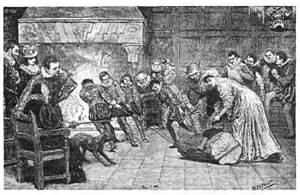The Yule Log
|

|
|
Also On This Site
|
|
Christmas
|
|
|
Share This Page
|
|
|
|
|
|
|
Follow This Site

|
 |
|
|
|
|

|
The Yule Log is a Christmas tradition that predates nearly all other Christmas traditions.
 People in the Northern Europe in the Middle Ages were used to celebrating the midwinter solstice, the shortest day of the year, when the promise of the warmer, longer days of spring was just around the corner. One of the ways that these people celebrated this time of year was to burn a set of special wood, for days at a time. The name for this festival was "Jol," also known as "Jule." The first syllable in this word was pronounced with a "y" sound, and the word morphed into having that letter at its beginning: Yule.
People in the Northern Europe in the Middle Ages were used to celebrating the midwinter solstice, the shortest day of the year, when the promise of the warmer, longer days of spring was just around the corner. One of the ways that these people celebrated this time of year was to burn a set of special wood, for days at a time. The name for this festival was "Jol," also known as "Jule." The first syllable in this word was pronounced with a "y" sound, and the word morphed into having that letter at its beginning: Yule.
One advent of the bonfire tradition was that people would bring the bonfire into their homes, carrying a small tree inside (in some cases, singing all the while) and cutting one large log to burn in the fireplace. This became the Yule Log. As the log was lit, people would ask for protection for their family and their fields. The log (or logs) was (or were) meant to be kept burning for at least 12 hours and, in some case, 12 days (the entire 12 Days of Christmas).
Once the Yule Log burning was at an end, people would scatter the ashes on their fields. Good crops would usually follow.
Another related tradition is the buche de Noel, a French sweet food (mainly chocolate) in the shape of a Yule Log. This food tradition has spread to other countries, notably the United Kingdom and many parts of the United States.